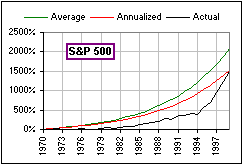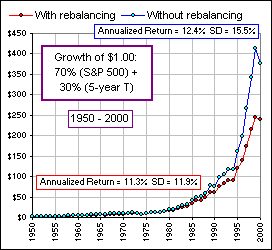| the Rebalancing Bonus |
Once upon a time, Bernstein considered the effect of rebalancing a portfolio consisting of two assets, A and B.
>Like Stocks and Bonds?
Yes, or S&P 500 and Foreign or Large and Small Cap or ...
>Okay, okay. I get it.
Fine. Suppose that, over the past umpteen years, the average annual return on asset A is
a and the average annual return on asset B is b and we devote a fraction
x of our portfolio to asset A (example: x = 0.70) and a fraction
y = 1 - x to asset B (example: y = 0.30), and we rebalance each year in
order to maintain this x:y ratio ... then what's the average annual return of our portfolio?
>Give me an example.
Okay, suppose we devote 70% of our portfolio to A and 30% of B and their average returns
are 10% and 8% respectively.
>Our average portfolio return would be 70% of 10% plus 30% of 8% which is ... uh ...
That's 9.4%, namely the weighted average of the individual average returns. In general, it'd
be x a + y b.
>You can prove that, I suppose.
Yes. Suppose that, over N years (months? days?) the returns ...
>No, I don't need to see any proof! I'll take your word ...
... the returns for asset A are
a1, a2, ... aN
with average a = (1/N){a1+a2+ ... +aN}
= (1/N)Σak
where Σ means we add them all together,
and the returns for asset B are
b1, b2, ... bN
with average b = (1/N){b1+b2+ ... +bN}
= (1/N)Σbk
then our annual portfolio returns, each year, are
(x a1+y b1), (x a2+y b2), ...
(x aN+y bN)
or, to put it more simply,
(x ak+y bk) in year k (where k = 1, 2, 3, ... N).
>Are you're rebalancing each year, to maintain the x and y fractions?
Yes, of course. Didn't I say that already? Pay attention.
The average return, for our portfolio, is then the average of all those
annual portfolio returns, namely
(1/N)Σ(x ak+y bk)
= x {
(1/N)Σak}
+ y {
(1/N)Σbk}
= x a + y b.
|
>So that's our portfolio return, eh?
That's our AVERAGE annual return. If you got this average annual return every year you'd be one lucky fella. (See Average & Annualized.) Figure 1 shows the actual S&P 500 and a portfolio which got, each year, the Annualized Return (annualized over 1970-2000) and one which got the Average Return (averaged over 1970-2000). >I like the Average!
|  Figure 1 |
What you REALLY want to know, in order that your portfolio end up after umpteen years with the correct value, is the Annualized return.
>I assume the annualized portfolio return is the weighted average of the annualized returns for A and B.
Wrong! That's okay with the Average Returns, but not the Annualized.
That's where our Rebalancing Bonus comes in.
>I was wondering when you'd get around to that.
Our portfolio Gain Factor, each year, is 1+Annual Return and since our annual returns are
(x ak+y bk), our Gain Factor (during year k) is:
(1+x ak+y bk) so, to get the Total Gain over N years,
namely (FinalPortfolio)/(Initial Portfolio), we multipy these annual Gain Factors together,
getting:
(1+x a1+y b1)
(1+x a2+y b2)
(1+x a3+y b3)
... (1+x aN+y bN)
= Π (1+x ak+y bk)
where Π means we multiply them all together.
If we rebalance each year to maintain the x:y allocation
then our portfolio, after N years,
would have grown by a Gain Factor
Π (1+x ak+y bk)
giving the final value of a $1.00 portfolio, With rebalancing.
On the other hand, the price of asset A would have grown by a Gain Factor
Π (1+ak)
the final value of a $1.00 portfolio devoted to asset A
and the price of
asset B would have grown by a Gain Factor
Π (1+bk)
the final value of a $1.00 portfolio devoted to asset B.
Conclusion? Had we NOT rebalanced, but put $x into asset A and $y into
asset B and left them there, our portfolio would have grown
by a Gain Factor:
xΠ (1+ak) +
yΠ (1+bk)
the final value of a $1.00 portfolio Without rebalancing.
>Put $x into asset A? What does that mean?
If our portfolio starts with $1.00 and x = 0.70 and y = 0.30 then we'd put
$0.70 into asset A, that's $x, and ...
>And $0.30 into asset B, right?
Right. So now we want to compare the Total Gain Factor With and
Without rebalancing.
>Remind me. What are the ...?
We ask: Which is larger?
(1)
With rebalancing: Π (1+x ak+y bk)
giving the final value of a $1.00 portfolio, With rebalancing
or
(2)
Without rebalancing: xΠ (1+ak) +
yΠ (1+bk)
giving the final value of a $1.00 portfolio, Without rebalancing
|
>Don't tell me! The Rebalancing Bonus is the difference, eh?
|  Figure 2 |
>So I'll ask again. What's the rebalancing bonus?
We compare the annualized return when we rebalance with the weighted average of the two annualized returns for assets A and B.
>Huh?
If our annualized Gain Factor With rebalancing is G, then, applying this
annualized Gain Factor to a $1.00 portfolio N times gives the final portfolio, namely
GN which is given by (1), above. Hence:
(3) GN = Π (1+x ak+y bk) giving the final value of a $1.00 portfolio, With rebalancing.
On the other hand, if the annualized Gain Factors for each of assets A and B are
P and Q respectively, then:
(4)
PN = Π (1+ak)
and
QN = Π (1+bk)
and the weighted average of these annualized Gain Factors is:
x P + y Q.
>Don't tell me! We want to compare G with x P + y Q, right?
Right.
>And the rebalancing bonus is {
G - (x P + y Q) }, right?
Right again.
>So, is this really a bonus or is it a ... uh ...
Deficit?
>Thank you.
For the 70% (S&P) + 30% (5-yr T) example, the annualized returns for each (over the period from 1950 to 2000) are 13.1% and 6.2% respectively so the weighted average (with the 70/30 split) is 70% x (13.1) + 30% x (6.2) = 11.0% whereas the actual annualized return, With rebalancing, is ...
>I get 12.4%, from Figure 2.
No, that's Without rebalancing. With rebalancing, it's 11.3%, the red curve from Figure 2.
>So the rebalancing bonus is 11.3% - 11.0% = 0.3%, right?
Right.
>So it IS a bonus, for that example, but is it ALWAYS a bonus?
We'll see ...
 for PART II
for PART II